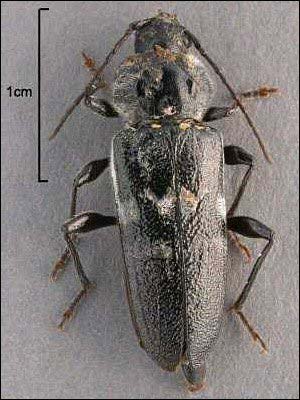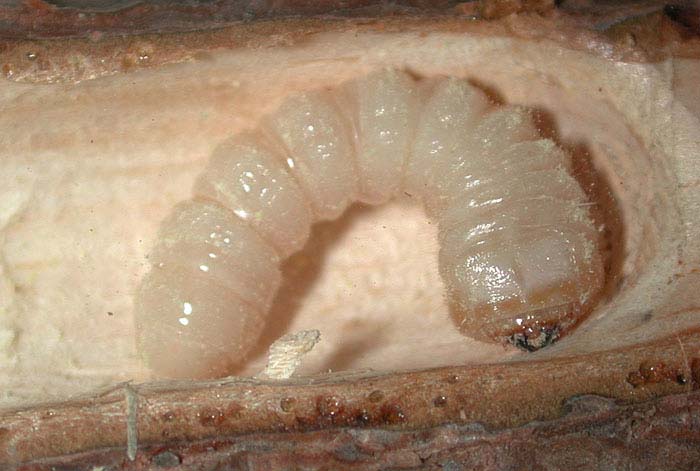PESTS AND DISEASES OF FORESTRY IN NEW ZEALAND
Hylotrupes bajulus - setting the record straight
Scion is the leading provider of forest-related knowledge in New Zealand
Formerly known as the Forest Research Institute, Scion has been a leader in research relating to forest health for over 50 years. The Rotorua-based Crown Research Institute continues to provide science that will protect all forests from damage caused by insect pests, pathogens and weeds. The information presented below arises from these research activities.
NOT PRESENT IN NEW ZEALAND
From Forest Health News 196, July 2009.
Hylotrupes bajulus (Cerambycidae) is a serious pest of seasoned coniferous timbers (particularly Pinus spp.) and can cause considerable damage in buildings, particularly in Europe. It is a European/Asian species that has established in North America, South America, South Africa and, more recently, in Perth, Western Australia.
In the February 2009 issue of the Ministry of Agriculture Biosecurity New Zealand’s Biosecurity Magazine there was an article describing New Zealand’s involvement in the eradication campaign being carried out in Perth (van Schagen & Bain 2009). Hylotrupes bajulus had previously been eradicated from eastern Australian states in the1950s and 1960s.

(Photo courtesy Department of Agriculture, Western Australia)
The above article has prompted several enquiries about the status of H. bajulus in New Zealand. Unfortunately there are several literature sources that state that H. bajulus is established here. Perhaps the most important of these is CAB International’s Crop Protection Compendium (http://www.cabicompendium.org/cpc/) but there are others as discussed below.
The purpose of this note is to set the record straight and reiterate that H. bajulus is not established in New Zealand and summarise the literature as it pertains to New Zealand.
The first record of H. bajulus in New Zealand is that of Bates (1874) who states “Two specimens taken by Mr Lawson at Auckland, differing in no respect from the European insect. Evidently introduced.” Hutton (1904), in a catalogue of New Zealand’s fauna, refers to Bates but adds no further records.
Thomson (1922) also refers to Bates 1874) and tells us that “it perforates the wood” and can bore through sheet-lead.
Miller (1925) (in what amounts to the first New Zealand text book of forest entomology) refers to Hutton and says “The larvae attack timbers in buildings, but have not yet been recorded in the Dominion”.
Milligan (1961) says a specimen in the Broun collection (which is housed in the British Museum, London) is stated to be the basis for inclusion of the name in an index of New Zealand beetles prepared by Hudson (1923), but Blair (1937) states that it was erroneously labelled. The specimen is, in fact, Gracilia minuta.
Milligan (1961) also says “In personal communications officers of the Entomology Division, Department of Scientific and Industrial Research, Nelson, have recently stated that the division has no records of occurrences of Hylotrupes bajulus and that there are no specimens of larvae or adults taken in New Zealand in the collections of Entomology Division, Cawthron Institute, or, as far as is known, in private collections in Nelson”.

Milligan (1961) further states “In January 1949 Kelsey identified a larva of Hylotrupes taken from pine wood used in a piano accordion imported from Italy by a Wellington firm in 1948. A flight hole which had penetrated clear plastic used as an overlay on the wood was also present when he examined the instrument, but had not been apparent when the accordion was sold.
It is believed that this is the first occurrence in New Zealand since 1874 that has been brought to the attention of an entomologist. In August 1956 Kelsey identified a second larva from a pine sapwood machinery- packing case imported from the United Kingdom. In both instances identifications were made on larval characteristics and were confirmed by comparison with specimens obtained from South Africa.
During the 1950s, 1960s and 1970s Hylotrupes bajulus was quite a common interception at New Zealand ports in pine casewood, dunnage etc. Many of the specimens are in the National Forest Insect collection housed at Scion.
Duffy (1963), in a much cited monograph of Australasian cerambycids, lists H. bajulus as being present in New Zealand. This error is unfortunate because Bob (R.H.) Milligan (referred to above) was in correspondence with Duffy leading up to this publication (he was sending New Zealand cerambycid larvae to him) and told him that H. bajulus was only an interception in New Zealand, i.e. there is no evidence that it established here. This Duffy publication is often cited as the evidence that H. bajulus is in New Zealand.
In 1967 Milligan published a paper on the susceptibility of New Zealand podocarp timbers to Hylotrupes bajulus in the New Zealand Entomologist. Going by the title and considering where the paper was published it is easy to understand why people would assume that H. bajulus occurs in New Zealand. However when the paper is read in its entirety it is obvious that Milligan was not saying this, he was discussing what might happen if it did establish here.
Becker (1968) states that H. bajulus occurs in New Zealand although there a couple of contradictions. He quotes Duffy (1960) and says “According to Duffy (1960), the house longhorn beetle is today found as a wood-destroying pest in the following areas: ... Australasian region: Australia, New Zealand... This is in the introduction but the summary reads “A general report is given of the distribution of the house longhorn beetle Hylotrupes bajulus (L.) Serville in Germany, in Europe and in other Continents. Severe damage is known from the most European countries, South Africa, the east coast of Australia, the eastern states of the USA and Argentina (Figure 3).” Note that there is no mention of New Zealand here but if we look at Figure 3 (a map) it shows it as present in New Zealand.
There is a paragraph in the Becker paper discussing the New Zealand situation and it draws on Milligan (1961) and only mentions interceptions (this is not the term used in the paper but it is obvious that is what is meant because it mentions packing cases etc).
Leschen et al (2003) (in a list of beetle genera found in New Zealand) do not include Hylotrupes and neither do Bain (1974, 1977) or Milligan (1970) in lists of established forest and timber insects.
Over the years many samples of suitable H. bajulus host material have been dissected and examined in the Scion Forest Protection diagnostic laboratory but H. bajulus has never been found in or reared from such material. For entomologists familiar with cerambycid larvae the identification of larval material is quite straightforward even although cerambycid larvae in general superficially look much the same. Microscopic examination is required.
In summary, there is no evidence that Hylotrupes bajulus is established in New Zealand although the opportunity for it to do so remains. If it did establish it has the potential to be a very serious pest of untreated coniferous timber.
References
Bain, J. 1974. Overseas wood- and bark-boring insects intercepted at New Zealand ports. New Zealand Forest Service Technical Paper 57.
Bain, J. 1977. Overseas wood- and bark-boring insects intercepted at New Zealand ports. New Zealand Forest Service Technical Paper 63.
Bates, H.W. 1874. On the longicorn Coleoptera of New Zealand. Annals and Magazine of Natural History Series 4, 14: 118-131.
Blair, K.G. 1937. Synonymy of the Cerambycidae of New Zealand. Entomologist’s Monthly Magazine 73: 261.268.
Becker, H. 1968. Die geographische Verteilung des Haus Longhornkafers – Hylotrupes bajulus (Linneaus) Col., Cerambycidae (Serville). Zeitschrift für Entomologie 61: 253
282.
Duffy, E.A.J. 1963. A monograph of the immature stages of Australasian timber beetles (Cerambycidae). British Museum, London.
Hutton, F.W. 1904. Index Faunae Novae Zelandiae, London, Dalau.
Hudson, G.V. 1923. An index of New Zealand beetles. Transactions of the New Zealand Institute 54: 353-399.
Leschen, R.A.B., Lawrence, J.F., Kuschel, G., Thorpe, S., Wang, Q. 2003. Coleoptera genera of New Zealand. New Zealand Entomologist 26: 15-28.
Miller, D. 1925. Forest and Timber insects in New Zealand. Bulletin 2, New Zealand Forest Service, Wellington.
Milligan, R.H. 1961. The European house borer. Hylotrupes bajulus L. A possible pest to New Zealand. Forest Research Institute, New Zealand Forest Service, Research Note 25.
Milligan, R.H. 1967. Susceptibility of New Zealand podocarp timbers to Hylotrupes bajulus Linnaeus (Coleoptera: Cerambycidae). New Zealand Entomologist 3: 52-56.
Milligan, R.H. 1970. Overseas wood- and bark-boring insects intercepted at New Zealand ports. New Zealand Forest Service Technical Paper 57.
Thomson, G.M. 1922. The naturalisation of animals and plants in New Zealand. Cambridge University Press
van Schagen, J., Bain, J. 2009. New Zealand’s part in Australia’s fight with the European House Borer. Biosecurity
89: 14-15.
This information is intended for general interest only. It is not intended to be a substitute for specific specialist advice on any matter and should not be relied on for that purpose. Scion will not be liable for any direct, indirect, incidental, special, consequential or exemplary damages, loss of profits, or any other intangible losses that result from using the information provided on this site.
(Scion is the trading name of the New Zealand Forest Research Institute Limited.)



